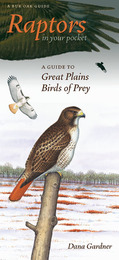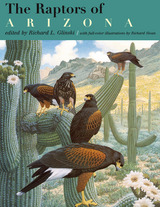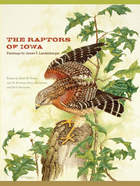3 books about Raptors

Raptors in Your Pocket
A Guide to Great Plains Birds of Prey
Dana Gardner
University of Iowa Press, 2006
This newest addition to Iowa's successful series of laminated guides is a welcome aid to identifying the many challenging raptors of the Great Plains, from northern Minnesota to northern Texas. Illustrator Dana Gardner has created fourteen panels showing twenty-six species perched and in flight with complete plumage variations---dark phases, light phases, and juvenile and adult male and female forms. The text also includes length and wingspan, common and scientific names, and status such as common resident or winter visitor.Raptors are notoriously hard to identify, and Gardner has worked hard to make this guide useful for beginning birders as well as those more experienced in the field. Keep Raptors in Your Pocket in your car or backpack---or pocket!---during spring and fall migration and summer nesting season for help in identifying such relatively common species as the light and dark forms of the red-tailed hawk, the male and female merlin and American kestrel, and the juvenile, intermediate, and adult forms of the Swainson's hawk as well as such uncommon visitors as white-tailed, swallow-tailed, and Mississippi kites.
[more]

The Raptors of Arizona
Edited by Richard L. Glinski, with full-color illustrations by Richard Sloan
University of Arizona Press, 1998
Thousands of birdwatchers come to Arizona each year seeking rare or intriguing species, and for those watching the skies the additional sighting of a bird of prey is a reward in itself. The Grand Canyon state boasts the most dramatic assortment of raptors in North America: hawks, eagles, falcons, kites, and owls, plus vultures and condors. Here can be found nearly all the raptor species of the continental United States and also established populations of species associated with Mexico, such as the Gray Hawk, Common Black-Hawk, Zone-tailed Hawk, and Whiskered Screech-Owl.
Arizona's raptors are found in an unrivaled diversity of habitats, from saguaro cactus forests where tiny Elf Owls nest to the Vermilion Cliffs, where the gigantic California Condor was introduced in 1996. Yet many species live in habitats that are now jeopardized by degradation or development, making an understanding and appreciation of raptors crucial to their survival.
The Raptors of Arizona brings together the knowledge and insights of 29 raptor and wildlife authorities who provide original information and syntheses on Arizona's 42 raptor species, with an emphasis on aspects of their natural history in Arizona. A chapter on each bird includes its description, a range map, and information on its distribution, habitat, life history, and status. Additional chapters cover conservation, habitats, where and when to watch raptors, and the sport of falconry. The book is enhanced by 42 full-color illustrations by Richard Sloan, one of the premier wildlife artists in North America, whose paintings were commissioned by the Arizona Wildlife Foundation specifically for this project. Co-published with the Arizona Game and Fish Department.
Arizona's raptors are found in an unrivaled diversity of habitats, from saguaro cactus forests where tiny Elf Owls nest to the Vermilion Cliffs, where the gigantic California Condor was introduced in 1996. Yet many species live in habitats that are now jeopardized by degradation or development, making an understanding and appreciation of raptors crucial to their survival.
The Raptors of Arizona brings together the knowledge and insights of 29 raptor and wildlife authorities who provide original information and syntheses on Arizona's 42 raptor species, with an emphasis on aspects of their natural history in Arizona. A chapter on each bird includes its description, a range map, and information on its distribution, habitat, life history, and status. Additional chapters cover conservation, habitats, where and when to watch raptors, and the sport of falconry. The book is enhanced by 42 full-color illustrations by Richard Sloan, one of the premier wildlife artists in North America, whose paintings were commissioned by the Arizona Wildlife Foundation specifically for this project. Co-published with the Arizona Game and Fish Department.
[more]

The Raptors of Iowa
James F. Landenberger, Dean M. Roosa, Jon W. Stravers, Bruce Ehresman, Rich Patterson
University of Iowa Press, 2013
This long-awaited collection of James Landenberger’s paintings of Iowa birds of prey presents thirty-two full-page, full-color species, from the common turkey vulture to the red-shouldered hawk of Mississippi River woodlands to the little northern saw-whet owl. Four naturalists who have devoted their lives to conserving wilderness habitats and species have written essays to complement the paintings.
Thanks to state and federal laws and a shift in public attitude, birds of prey are no longer seen as incarnations of ferocity but as creatures superbly attuned to their lives and surroundings. Although Iowa unfortunately leads the way in the amount of wildlife habitat that has been destroyed, conservation organizations and state agencies have also led the way toward successful raptor restoration projects, among them a roadside nest box program for the American kestrel, a project to restore peregrine falcons to their historic eyries, and a relocation program that should ensure a sustainable population of ospreys. The recent spectacular recovery of the bald eagle, whose nests had vanished from the state for seventy years, is particularly encouraging.
There can be no substitute for seeing thousands of broad-winged hawks soaring high overhead during migration, a great horned owl perching in silhouette at dusk, or a Cooper’s hawk plunging toward its prey along the roadside. But Jim Landenberger’s meticulously detailed paintings go a long way toward conveying the remarkable beauty of the American kestrel and other falcons, the grace of the swallow-tailed kite, the immaculate mystery of the snowy owl and its fellow owls, the glistening head feathers of an adult bald eagle, and the piercing defiance so characteristic of our larger hawks. [more]
READERS
Browse our collection.
PUBLISHERS
See BiblioVault's publisher services.
STUDENT SERVICES
Files for college accessibility offices.
UChicago Accessibility Resources
home | accessibility | search | about | contact us
BiblioVault ® 2001 - 2024
The University of Chicago Press









